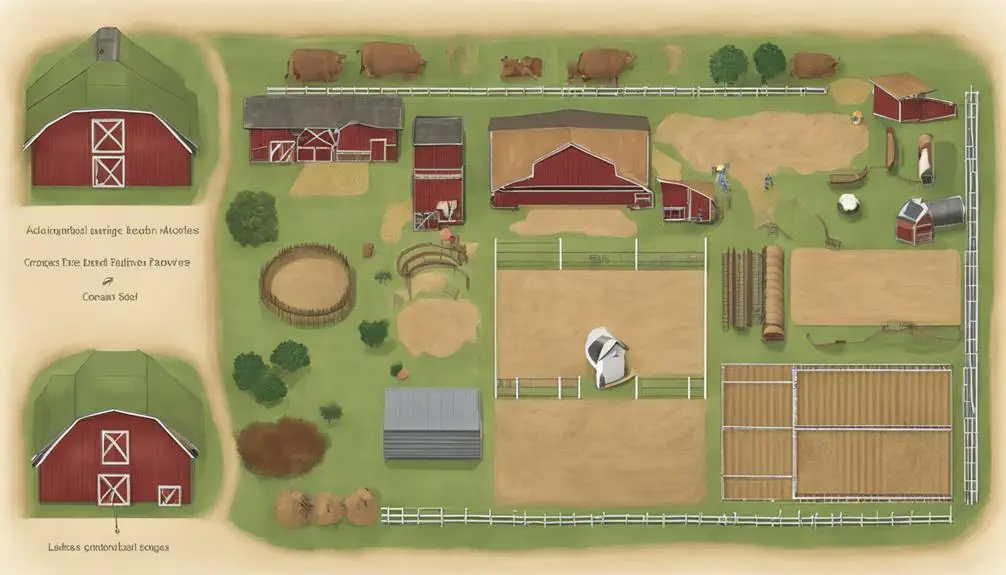When optimizing barn layouts for efficiency and productivity, strategic placement is essential. Position stalls, storage areas, and workspaces thoughtfully for operational efficiency. Well-organized layouts maximize space usage and functionality. Placing stalls correctly streamlines feeding and grooming. Storing items near the entrance saves time. Factors like center aisles, tack rooms, and compliance with building codes influence design. Proper spacing and customizing for livestock comfort are vital. Guarantee safety with non-slip flooring and clear pathways. Strategic organization of components enhances workflow. Consider natural light and ventilation for a comfortable environment. Mastering these elements creates a functional and safe barn layout.
Importance of Efficient Barn Layouts

Efficient barn layouts are paramount for optimizing operational efficiency and ensuring smooth workflow processes in livestock management. When designing a horse barn floor plan, strategic placement of stalls, storage areas, and workspaces is vital. A well-thought-out layout not only maximizes space utilization but also enhances functionality, reducing unnecessary movements and improving overall productivity.
In a horse barn, the floor plan plays a significant role in the daily management of horses. Proper placement of stalls within the barn layout can streamline feeding routines, grooming schedules, and veterinary care. Additionally, organizing storage areas near the entrance for easy access to feed, equipment, and supplies can save time and effort during daily operations.
Moreover, a thoughtfully designed horse barn floor plan contributes to the safety and well-being of both horses and handlers. Clear pathways, secure stall placements, and well-defined workspaces facilitate better monitoring of livestock and reduce the risk of accidents. By investing time in planning an efficient barn layout, owners and workers can enjoy cost savings, increased efficiency, and overall satisfaction in their daily operations.
Factors Influencing Barn Design
Considering the number of animals to be housed and the equipment to be stored, barn design is intricately influenced by various factors that impact the functionality and efficiency of the facility. When creating horse barn plans or layouts for livestock, several key elements need to be taken into account:
- Center Aisle: The inclusion of a center aisle in barn design allows for easy movement of animals, equipment, and personnel. It enhances accessibility and facilitates efficient workflow within the barn.
- Tack Rooms: Incorporating tack rooms in the barn layout provides a designated space for storing saddles, bridles, and other equipment. Tack rooms help in organizing gear and ensuring it remains easily accessible when needed.
- Local Building Codes: Adhering to local building codes and regulations is essential in the design process. Compliance with these codes ensures the safety of the structure, occupants, and animals within the barn. It also helps avoid potential legal issues related to construction and operation.
Considering these factors alongside the specific needs of the animals and equipment will result in a well-designed barn that is functional, safe, and efficient.
Optimizing Space for Livestock Comfort

To enhance the comfort of livestock in a barn setting, it is essential to focus on optimizing the available space efficiently and effectively. The barn floor plan plays a critical role in ensuring livestock comfort. Proper stall dimensions, typically ranging from 10×10 to 12×12 feet, provide adequate space for horses to move comfortably. Including a middle aisle of at least 12 feet not only allows for proper ventilation but also enables easy monitoring of the animals, essential for their care.
Incorporating a tack room into the barn layout is beneficial for optimizing space. This dedicated room helps organize and store equipment, ensuring a clutter-free environment that contributes to the overall comfort of the livestock. Customizing your horse barn to include a feed room is also important. This space is essential for storing supplements and feed securely, protecting them from pests and maintaining the health and nutrition of the horses.
When designing your barn layout, consider these elements carefully to create a space that prioritizes the comfort and well-being of your livestock.
Enhancing Workflow and Safety
Enhanced workflow and safety in barn layouts are achieved through strategic organization and implementation of safety features. To optimize the efficiency and safety of your barn layout, consider the following:
- Non-Slip Flooring: Installing non-slip flooring in high-traffic areas and around water sources can prevent accidents and promote stable footing for both humans and animals.
- Clear Pathways: Maintaining clear pathways throughout the barn guarantees easy movement and reduces the risk of tripping or collisions.
- Sliding Doors: Incorporating sliding doors in areas such as feed storage or livestock pens can enhance workflow by providing easy access without obstructing pathways or requiring excessive swinging space.
Strategic Placement for Productivity

In optimizing barn layouts for productivity, strategic placement of components is crucial to streamline workflow efficiency. When designing horse barns, make sure there is enough space for easy movement and operation. Place the tack and equipment storage areas close to where they will be used most frequently to minimize time spent fetching supplies. Consider barn designs that incorporate natural light and ventilation strategically to create a comfortable environment for the horses while reducing energy costs. Efficient placement of feed storage areas near the feeding stations will simplify daily tasks and save time. Additionally, organizing the layout with safety in mind enhances the overall functionality of the barn. By carefully considering the placement of each element within the barn, you can create a workspace that promotes productivity and contributes to a more enjoyable experience for both you and your horses.
